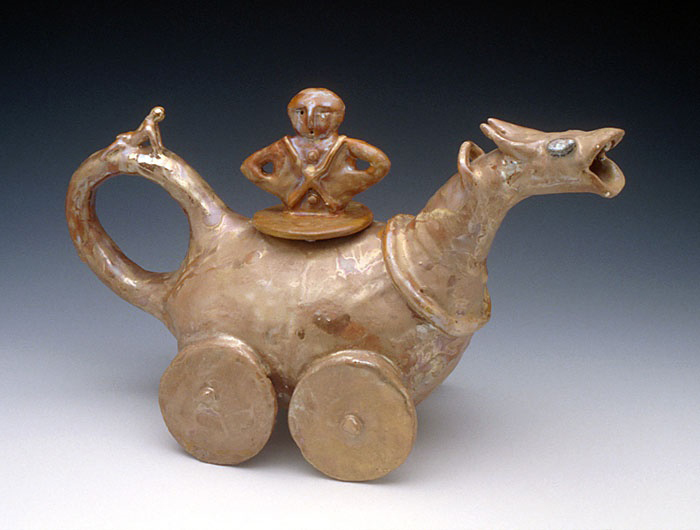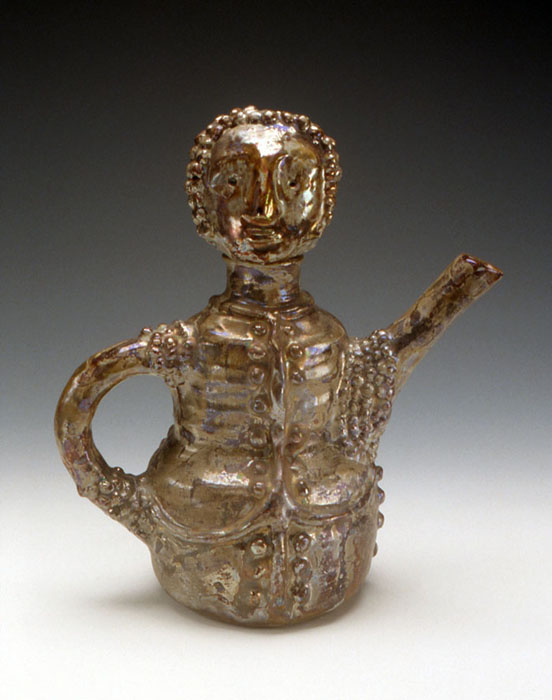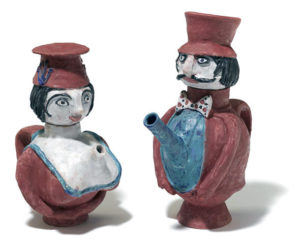“Beatrice Wood combines her colors like a painter, makes them vibrate like a musician. They have strength even while iridescent and transparent. They have the rhythm and luster both of jewels and human eyes. Water poured from one of her jars will taste like wine.”[i]– Anaïs Nin, Writer and Diarist
Beatrice Wood (American, 1893-1998) is known for her long extraordinary life as well as her passion for the arts. Her creative spirit led her on a journey that many would find remarkable. During her 105 years Wood explored drawing, painting, writing, the theater, and then, in her forties, she discovered clay. She devoted herself to this medium creating pottery that shimmered with iridescent luster glazes. Ultimately, it was this body of work that helped secure Wood’s place among the “pantheon of great American women artists.”[ii]
There are numerous examples of Wood’s work in the Kamm Collection. This impressive group, which ranges from lively figurative teapots to elaborate tea and dish sets, captures the essence of her style. In this blog post we will share some of these works with you and we will look at Wood’s life which “…glittered, sparkled, and seduced every bit as much as [her] luster pots.”[iii]
Youthful Rebellions
Wood was born in San Francisco, but she grew up in New York’s high society.[iv] For much of her childhood she was groomed to be “a dutiful debutante.”[v] Wood spent a year learning French at a convent in Paris, attended prestigious finishing schools, and took regular summer trips to Europe to ensure that her education was complete.[vi]
However, Wood’s love of art would soon change the trajectory of her life. In 1912, Wood rebuffed the idea of a coming-out party declaring that she wanted to become a painter.[vii] In response, her parents sent her, with a chaperone, to receive proper artistic training at the Académie Julian in Paris. Wood found the instruction “tediously academic” and promptly ran away from her chaperone.[viii] She rented an attic room in Giverny, Claude Monet’s hometown and, until her mother came to retrieve her, she painted morning, noon, and night. Once Wood was returned to Paris, she switched her focus to the performing arts. She received private acting and dance lessons with members of the Comédie-Française and she even had the opportunity to share the stage, albeit in minor roles, with leading stars of the time such as Sarah Bernhardt.[ix]
New York Dada
With the First World War looming on the horizon, Wood returned to the United States and continued to act with the French National Repertory Theatre in New York. However, after a chance meeting with the artist Marcel Duchamp, she soon found herself in the middle of the Dada art movement.[x] Wood’s relationship with Duchamp would be “the most influential of her life.”[xi]
When they met in 1916, Duchamp had “already secure[d] his formidable place among the history of modern art.”[xii] His pivotal work Nude Descending a Staircase, which was introduced at the New York Armory Show in 1913, had received widespread attention and he had created sculptures from his found object series called “ready-mades.”[xiii] Duchamp was the leader of the avant-garde New York Dada group. The Dadaists believed that art was not just a “gorgeous picture.”[xiv] Instead, “it could be anything.”[xv] Dada was “an expression of revolt” and freedom from traditional artistic values. [xvi] Through Duchamp, Wood was introduced to key figures in the New York Dada group. In particular, she met the “adventurous” modern art collectors Walter and Louise Arensberg, who would become her lifelong friends. [xvii] At the time the Arensberg’s patronage was vital to Dada and the group regularly gathered in their New York City apartment. At these legendary late night soirees Wood had the opportunity to mingle with artists such as Francis Picabia, Man Ray, Charles Demuth, and Joseph Stella.
Duchamp encouraged Wood to paint and draw even sharing his studio with her for a period. Her “sketchy” work, which could be described as “spontaneous and magical,” appealed to him.[xviii] When Duchamp (using the pseudonym R. Mutt) submitted his infamous urinal called Fountain to the 1917 Independents Salon exhibition, he pushed Wood to exhibit as well.[xix] One of her entries was a painting featuring a woman in a bath. Called A Little Water in Some Soap, it included, at Duchamp’s suggestion, an actual shell-shaped bar a soap carefully attached to ensure the figure’s modesty. [xx] The work received a great deal of publicity especially when it was discovered it was painted by a woman.
Duchamp also introduced Wood to Henri-Pierre Roché, a French diplomat, writer, and art collector.[xxi] Together the trio published The Blind Man, an avant-garde journal that reflected Dada ideals. Wood wrote for the magazine and her drawing of a striding stickman thumbing his nose was prominently displayed on the poster for the legendary Blindman’s Ball.
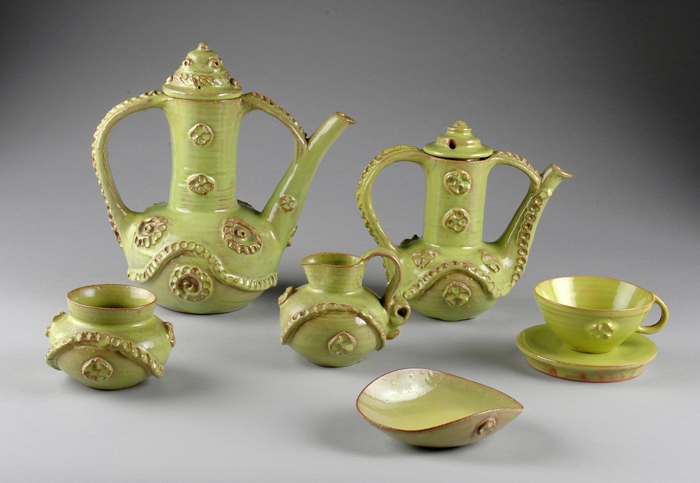
Pottery
After a stint in Montreal pursuing her acting career, Wood returned to New York in 1920.[xxii] She discovered upon her arrival that much of the Dada group had gone their separate ways. In search of a fresh start, Wood decided to move to Los Angeles. There, she could be close to the Arensbergs, who had recently relocated, as well as Jiddu Krishnamurti, an Indian guru from the Theosophical Society. Wood was introduced to Krishnamurti in the early 1920s and for many years he would provide her with “a sense of solace.”[xxiii]
In 1930 Wood followed Krishnamurti to Holland for one of his speaking engagements. While on this trip she acquired a set of six nineteenth century luster-glazed dessert plates at an antique store. Wood hoped to find a teapot to match. When her search was unfruitful, she innocently decided she could just make one. This simple thought launched a sixty-five-year career of making pottery. Wood has stated, “I never meant to become a potter…It happened very accidentally…”[xxiv]
Wood started by taking adult education classes at a local high school in Hollywood in 1933 and reading academic papers in the Bulletins of the Ceramic Society.[xxv] She then studied with the potter Glen Lukens at the University of Southern California and, in the 1940s, she worked under the guidance of her mentors Gertrud and Otto Natzler.[xxvi] They shared their knowledge of clay with her, but eventually sent Wood off on her own.[xxvii] She set up a studio in the city of Ojai, California and later, she moved outside of town to the grounds of the Happy Valley Foundation which was an extension of the Theosophical Society.
Kamm Collection
Wood’s pottery in the Kamm Collection reflects not only her interest in luster glazes, but also a playfulness and a Dada sense of freedom which always stayed with her. She did not treat her pots like precious objects, and she full-heartedly embraced experimentation. Wood stated, “perfection bores me…I do not want to know exactly what I am going to find when I open the kiln.”[xxviii]
Her luster glazed works in the Kamm’s collection shimmer in shades of gold, pink, green and blue. Her approach to this ancient technique “represented a new modernist frontier.”[xxix] While Wood initially created on-glaze decoration upon the surfaces of her forms, she eventually “developed a signature style of glazing, an all-over, in glaze luster.”[xxx] This is generated by simply throwing mothballs into an electric kiln to create a reduction firing.[xxxi] During this process the kiln is starved of oxygen and metallic salts are pulled to the surface of the glaze. While often unpredictable, Wood produced an exquisite range of results. As you study these forms, they constantly change as the surrounding light changes. It is almost as if “[Wood’s] colors are molded with light.”[xxxii]
Many of Wood’s vessels also contain figures or what she calls her “sophisticated primitives.”[xxxiii] These lively child-like creations can range from “clowns, dancing ladies, and lovesick maidens” to personal expressions of her “values, politics, and philosophies.”[xxxiv] In the Kamm Collection there are a selection of works, such as Dragon Teapot and Woman Teapot, that incorporate her figures. These figurative inclusions, which reflect her interest in folk and primitive art, are a significant part of her oeuvre.[xxxv] However, Wood did not see them as “serious sculpture.”[xxxvi] Instead, she says, “I just make little figures. I’m not even a craftsman. I am an artist, which has saved me.”[xxxvii]
By the 1950s Wood’s work was included in exhibitions at the Los Angeles County Museum of Art and the Metropolitan Museum of Art in New York.[xxxviii] In a relatively short period of time she had developed a solid reputation as an artist.[xxxix] In the years to come Wood would continue to be inspired by clay’s possibilities. At the age of ninety, she stated, “Though I am ready to die, my desire to [work] keeps me down here [in my studio], I will never have enough time, for once an idea is pursued, another pops up…”[xl] Wood passed away on her own terms not long after celebrating her 105th birthday.
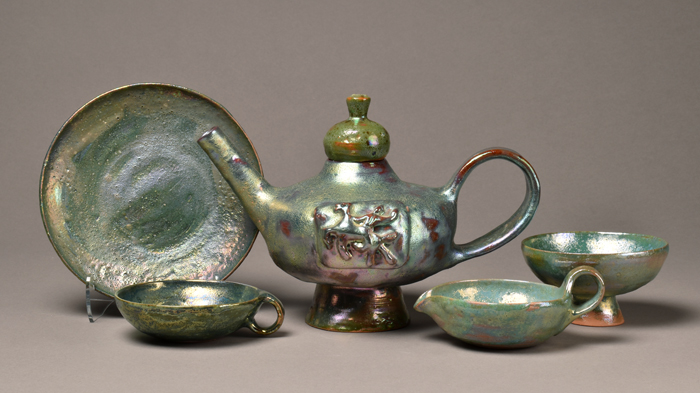
Further Reading/Viewing:
Asterisco, David. Beatrice Wood. 30 September 2009. (Video Clip)
Beatrice Wood Center for the Arts.
Clark, Garth. The Lustrous Art and Life of Beatrice Wood, Gilded Vessel. Madison, WI: Guild Publishing, 2001.
Cord, Maryann. Beatrice Wood at 97 Excerpt. 9 December 2013. (Excerpt from film by Carole Ewing McCartney.)
Naumann, Francis M. Intimate Appeal: The Figurative Art of Beatrice Wood. Oakland, CA: Oakland Museum, 1990.
Neif, Tom L. Beatrice Wood: Mama of Dada. 15 March 1994. Documentary film.
Oral History Interview with Beatrice Wood. Smithsonian Archives of American Art. 26 August 1976.
Wood, Beatrice. I SHOCK MYSELF, Beatrice Wood, Career Woman of Art. Atglen, Pennsylvania: Schiffer Publishing Limited, 2018.
Wood, Beatrice. The Angel Who Wore Black Tights. Ojai, CA: Rogue Press, 1982.
Notes:

